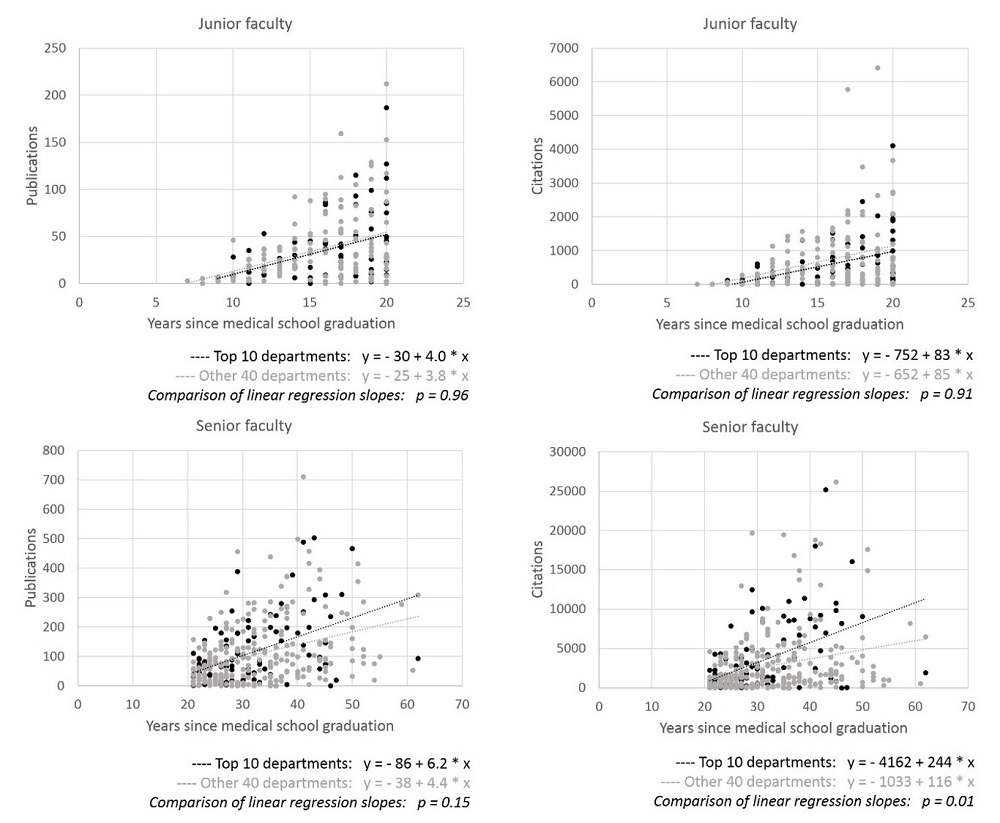C. Rosati1, N. P. Valsangkar1, P. N. Vardas1, L. Chabtini1, M. W. Turrentine1, J. W. Brown1, L. G. Koniaris1 1Indiana University School Of Medicine,Department Of Surgery,Indianapolis, IN, USA
Introduction: Academic success of individuals and research funding of their institutions are interrelated. We aimed to investigate which factors distinguish the cardiothoracic surgeons practicing at the top ranked departments from their peers.
Methods: Using online resources (2014 report of the Blue Ridge Institute for Medical Research, SCOPUS, institutional websites, CTSNet) we collected training information (place and timing of medical school and post-graduate education, attainment of a PhD) and academic metrics (publications, citations, H index) of the cardiothoracic (CT) surgeons practicing at the 50 departments of surgery with the highest NIH funding. We divided faculty members into Junior and Senior depending on the time (≤ 20 vs. >20 years, respectively) since graduation from medical school.
Results: Among 593 CT surgeons, 175 (30%) are practicing at the 10 departments (Top 10) with the highest NIH funding, while 418 (70%) at the remaining 40, with a median (range) number of CT surgeons per department of 15.5 (7-34) and 11 (1-24), respectively (p = 0.04), but no significant difference in seniority (junior: 41% of all at the Top 10 vs. 36% at the other; p NS). Senior CT surgeons of the Top 10 are more academically productive than their peers, while no such a difference is evident for junior faculty (see Graphic). CT surgeons of the Top 10 are more likely to have received at least part of their training at one of the Top 10 (66% of all, 72% of junior, and 62% of senior) than their peers (31%, 35%, and 29%, respectively; all p < 0.001). Any prior training at the same institution where they are currently faculty members is more prevalent in junior faculty of the Top 10 (58%) than their peers (40%; p = 0.001), with no such a difference for senior faculty (Top 10: 42%; other: 42%; p NS). No significant difference in the attainment of a PhD is found between the Top 10 (8% of all, 10% of junior, and 6% of senior) and the other institutions (10%, 13%, and 9%, respectively; all p NS), or in the prevalence of international medical graduates (Top 10: 19% of all, 17% of junior, 21% of senior; other: 21% of all, 19% of junior, 22% of senior; all p NS).
Conclusion: While senior cardiothoracic surgeons practicing at the top funded institutions are clearly more academically productive than their peers, no difference emerges for junior individuals. Faculty of the top funded institutions are more likely to have received their training at highly ranked institutions as well, with any prior training at that same institution particularly important in the recruitment of junior faculty. No difference is seen across institutions in the prevalence of surgeons with a PhD or who are international medical graduates.
